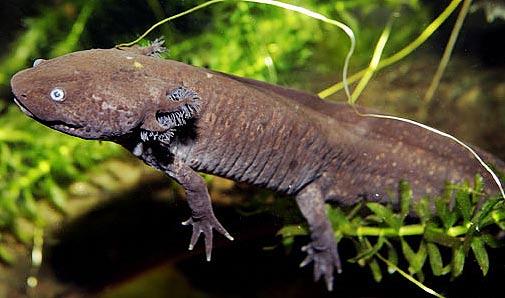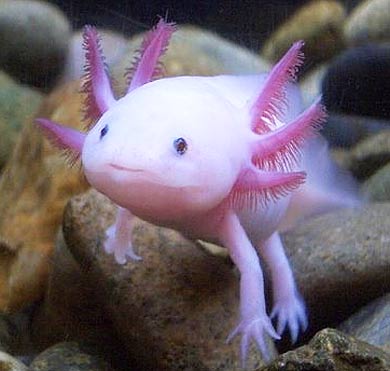Axolotl – Mexican Mudkip, Never Grows Up

The axolotl is a curious creature native to Mexico. It is best known in its cartoon form as a “Mudkip” in the Pokemon series. It is a type of salamander that does not complete its development in the adult phase – it stays a larva and never grows up. Thus, the gills remain and the axolotl is 100% aquatic, despite the small legs it has.
Adult axolotls range in size from 15 cm (5.85 in) to 45 cm (17.5 in) long and have a wide variety of colors, including grey, shades of brown, yellow and red. They also have harlequin mixtures of colors and patterns. They look like very large tadpoles, with legs and prominent gills. Female axolotls have wider bodies than males, and males have swollen clocae (multi-purpose posterior opening). They use their external gills to extract oxygen from water, but can also gulp air from the surface, using buccal pumping – opening and closing the bottom part of the mouth.

Shrinking Habitat
The axolotl’s natural habitat has always been restricted to two lakes in Mexico: Lake Chalco and Lake Xochimilco. Lake Chalco was drained to prevent annual flooding, so the species has been confined to the Xochimilco lake district, which has become a series of canals, more than a real lake.
Their wild habitat has been shrinking in recent years, due to pollution and the introduction of carp and other non-indigenous fish into the lake. These fish feed on the axolotl young and on the eggs. The Xochimilco lake and its surrounding wetlands are used for the supply of water to Mexico City, and the city’s increasing size is putting a strain on the species. There are as few as 700 to 1,200 individual Axolotls alive in the lake, located in six separate regions.
Axolotls used to be sold in Mexico City food markets and were a staple food of the Aztecs.

Doing Science Keeps Axolotls Alive
It is due to their value in scientific research, that the axolotls are almost guaranteed to survive as species, despite their natural habitat destruction. It is probably to do with them being neutenic – that they are able to regenerate and heal so effectively. Whole limbs can be cut off, which then grow back, and are 100% as good as the original. Their healing abilities and large, robust embryos, make them valuable scientific research tools.
They are also popular as pets, since they breed well in captivity and do not need dry land like other salamanders do. It is possible to artificially force metamorphosis in the axolotl, so that it does reach adulthood and then it will live on land. However this is a difficult process and in practice has shortened their lifespan from 15 years, to just 5 years.
